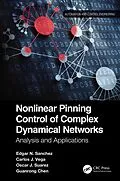This book presents two nonlinear control strategies for complex dynamical networks. First, sliding-mode control is used, and then the inverse optimal control approach is employed. For both cases, model-based is considered in Chapter 3 and Chapter 5; then, Chapter 4 and Chapter 6 are based on determining a model for the unknow system using a recurrent neural network, using on-line extended Kalman filtering for learning.
The book is organized in four sections. The first one covers mathematical preliminaries, with a brief review for complex networks, and the pinning methodology. Additionally, sliding-mode control and inverse optimal control are introduced. Neural network structures are also discussed along with a description of the high-order ones. The second section presents the analysis and simulation results for sliding-mode control for identical as well as non-identical nodes. The third section describes analysis and simulation results for inverse optimal control considering identical or non-identical nodes. Finally, the last section presents applications of these schemes, using gene regulatory networks and microgrids as examples.
Autorentext
Edgar N. Sanchez works at CINVESTAV-IPN, Guadalajara Campus, Mexico, as a professor of electrical engineering graduate programs. Carlos J. Vega received D.Sc. in Electrical Engineering degree from the Center for Research and Advanced Studies of the National Polytechnic Institute (CINVESTAV-IPN), Guadalajara, Mexico in 2020. His research interests include complex networks, nonlinear control, inverse optimal control, neural networks, and power systems. Oscar J. Suarez is a Professor of engineering programs for undergraduate and graduate programs both in Colombia and Mexico. Currently, he is a Junior Research fellow of the Ministerio de Ciencia Tecnología e Innovación (Minciencias) in Colombia. Guanrong Chen has been a Chair Professor and the Founding Director of the Centre for Chaos and Complex Networks, City University of Hong Kong, Hong Kong, since 2000.
Inhalt
I Analyses and Preliminaries 1 Introduction 1.1 Complex Dynamical Networks 1.2 Pinning Control 1.3 Sliding-Mode Control 1.4 Optimal Nonlinear Control 1.5 Artificial Neural Networks 1.6 Gene Regulatory Networks 1.7 Microgrids 1.8 Motivation 1.9 Book Structure 1.10 Notation 1.11 Acronyms Bibliography
2 Preliminaries 2.1 Nonlinear Systems Stability 2.2 Chaotic Systems 2.3 Complex Dynamical Networks 2.4 Sliding-Mode Control 2.5 Optimal Control 2.6 Recurrent High-Order Neural Networks Bibliography
II Sliding-Mode Control 3 Model-Based Control 3.1 Sliding-Mode Pinning Control 3.2 Simulation Results 3.3 Conclusions Bibliography
4 Neural Model 4.1 Formulation 4.2 Neural Identifier 4.3 Output Synchronization 4.4 Simulation Results 4.5 Conclusions Bibliography
III Optimal Control 5 Model-Based Control 5.1 Trajectory Tracking of Complex Networks 5.2 Non-Identical Nodes 5.3 Conclusions Bibliography
6 Neural Model 6.1 Trajectory Tracking of Complex Networks 6.2 Non-Identical Nodes 6.3 Discrete-Time Case 6.4 Conclusions Bibliography
IV Applications 7 Pinning Control for the p53-Mdm2 Network 7.1 p53-Mdm2 Model Regulated by p14ARF 7.2 Mathematical Description 7.3 Pinning Control Methodology 7.4 Behaviors of the p53-Mdm2 Network Regulated by p14ARF without Control Action 7.5 Behaviors of the p53-Mdm2 Network Regulated by p14ARF with Control Action 7.6 Conclusions Bibliography
8 Secondary Control of Microgrids 8.1 Microgrid Control Structure 8.2 Distributed Cooperative Secondary Control 8.3 Simulation Results 8.4 Conclusions Bibliography Index
